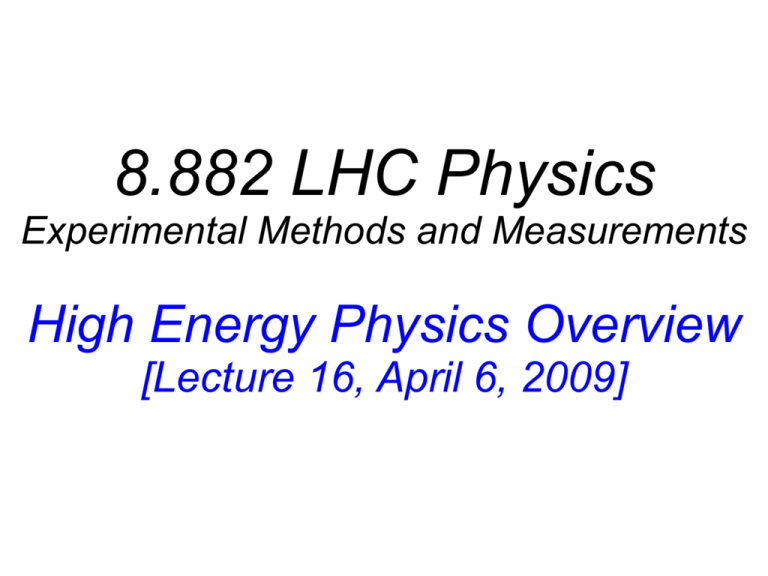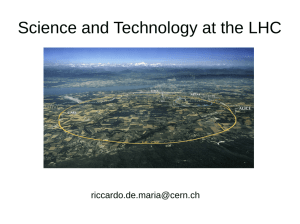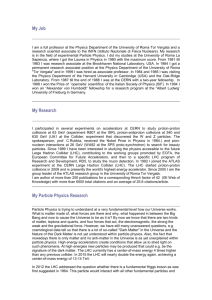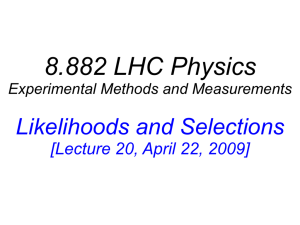ppt - MIT
advertisement

8.882 LHC Physics Experimental Methods and Measurements High Energy Physics Overview [Lecture 16, April 6, 2009] Organization Next lecture: Michael Betancourt ● ● Baysians versus Frequentists: lesson on statistics I will be on a plane at that time: so be nice to Michael Project 2 ● ● due April 9 (Wednesday) check web page for instructions, in particular triggers Project 3 ● B lifetime is coming up.... Final Conference Project ● ● planning for ? May 20 at 13:00am in the Kolker Room ? program should be fixed pretty quickly C.Paus, LHC Physics: High Energy Physics Overview 2 Lecture Outline High Energy Physics overview ● ● overview of the program B physics, LHCb experiment ● ● ● ● ● ● ● ● cross sections, production fractions, branching ratios lifetimes and lifetime ratios CP asymmetries, mixing and lifetime differences QCD and Electroweak top physics Standard Model Higgs SUSY extra dimensions C.Paus, LHC Physics: High Energy Physics Overview 3 HEP Program Overview Precursor: Planck mass, mP ● ● ● Schwarzschild radius: rS ; characteristic radius for which a particle would just turn into a black whole if all its mass was inside that radius Compton length: λ ; intrinsic position uncertainty for the position measurement of a particle due to its wave character as defined by QM Planck mass: particle has rS = λ/π Mass of a flea is about 5000 x mP C.Paus, LHC Physics: High Energy Physics Overview 4 HEP Program Overview Precursor: Charge Conjugation, C ● replacing a particle with its own antiparticle is called charge conjugation: operator in QM Precursor: Parity Inversion, P ● inverting the spacial coordinates is called the parity operation and is a QM operator Precursor: CP ● combining charge conjugation and parity inversion is called the CP operation E&M and QED completely symmetric under C and P Weak force ● ● violates C and P maximally CP also violated, less obvious (1964, K0, Cronin, Fitch) C.Paus, LHC Physics: High Energy Physics Overview 5 HEP Program Overview Big questions in High Energy Physics ● the matter problem ● ● ● ● where does matter originate from? which mechanism? what is the large amount of dark matter in the universe? (what is the even larger amount of dark energy?) matter anti-matter asymmetry and CP violation ● ● ● ● why is there so much matter and so little anti-matter? big bang should have produced them in equal amounts CP operation has to be asymmetric (violates symmetry) Standard Model CP violation cannot explain observed asymmetry ● ● could explain existence of just one galaxy but not the universe there must be something else, CP violating, generating the rest C.Paus, LHC Physics: High Energy Physics Overview 6 HEP Program Overview Big questions in High Energy Physics, continued ● Hierarchy problem(s) ● ● ● general idea: fundamental parameters are much smaller/bigger than parameters measured in the experiment why is the weak force 1032 times stronger than gravity? or otherwise put: why is the Higgs mass that much smaller then the Planck mass? to explain this in a natural fashion new physics should appear in vicinity of the Higgs boson (what ever that means) C.Paus, LHC Physics: High Energy Physics Overview 7 LHCb Experiment and B Physics C.Paus, LHC Physics: High Energy Physics Overview 8 LHCb Experiment and B Physics C.Paus, LHC Physics: High Energy Physics Overview 9 LHCb Experiment and B Physics C.Paus, LHC Physics: High Energy Physics Overview 10 LHCb Experiment and B Physics Measure triangle in all possible independent ways and confirm its closure C.Paus, LHC Physics: High Energy Physics Overview 11 LHCb Experiment and B Physics In the Standard Model we expect: Beyond the Standard Model there could be: Mixing frequency different: unitarity triangle not closed! C.Paus, LHC Physics: High Energy Physics Overview 12 Atlas&CMS: High pT Physics Standard Model: Electroweak - Parameters ● ● ● masses: fermion masses (12), boson masses (4) couplings(4): αQED, αQCD, gW, ν0 4 quark and 4 leptonic mixing parameters Standard Model ● ● ● ● ● Classical Mechanics is ultimately described by a Lagrangian and the Hamilton Principle Classical Field theory adds the field to CM and the Lagrangian density Quantum Mechanics adds uncertainty principles and Operators SM is a Quantum Field Theory (quantize classical field) in particular needed to explain particle reactions C.Paus, LHC Physics: High Energy Physics Overview 13 Generation of Mass with Higgs Boson A gauge invariant Lagrangian cannot support simple by hand introduced mass terms because they destroy the gauge invariance Introducing an additional scalar field modifies the derivative and thus the gauge transformation Additional terms appear now in the Lagrangian which have the form of mass terms Vacuum expectation value non zero, particle move through a field which gives them mass C.Paus, LHC Physics: High Energy Physics Overview 14 A Popular Explanation [CERN] Empty space is like a room full of chattering scientists A highly regarded scientist arrives.... (she represents a particle) While moving through the room people gather around her producing resistance against her motion here interpreted as mass C.Paus, LHC Physics: High Energy Physics Overview 15 A Popular Explanation [CERN] A rumor is created and crosses the room. The people in the room create a clustering just by themselves which is interpreted as the Higgs boson. C.Paus, LHC Physics: High Energy Physics Overview 16 Goal of Electroweak Physics Measure electroweak reactions to constrain Standard Model ● ● ● direct measure of SM parameters mt, mW, .... measurements: Oi(mW, mZ, mt, mH,....) example: cross section, asymmetries, polarizations C.Paus, LHC Physics: High Energy Physics Overview 17 Interpreting Electroweak Results in SM All essential world EW measurements compared to the predicted value Some of the measurements are very high level, combining very many individual measurements C.Paus, LHC Physics: High Energy Physics Overview 18 Interpreting Electroweak Results in SM The one free unknown is obviously the most important goal Higgs mass enters as a logarithm into the electroweak corrections Either Higgs is found or SM is shown to be wrong C.Paus, LHC Physics: High Energy Physics Overview 19 Interpreting Electroweak Results in SM Indirect information of the top and W masses versus direct measurement C.Paus, LHC Physics: High Energy Physics Overview 20 SuperSymmetry Why do the theorists like it? ● ● ● ● ● it solves the hierarchy problem! coupling constants unify at the Grand Unified Theory, GUT, scale it may provide a dark matter candidate well.... it is very nice and symmetric (super symmetric) why some experimentalists do not like it: much more new parameters ● many new CP violating phases, we did not see any ● why does it have to be around the corner? ● C.Paus, LHC Physics: High Energy Physics Overview 21 SuperSymmetry What is SUSY? C.Paus, LHC Physics: High Energy Physics Overview 22 Searches for Signatures C.Paus, LHC Physics: High Energy Physics Overview 23 Search for sbottom at Tevatron C.Paus, LHC Physics: High Energy Physics Overview 24 Search for stop at Tevatron C.Paus, LHC Physics: High Energy Physics Overview 25 Conclusion High Energy Physics at LHC ● ● ● a huge amount of physics can be done most exciting is the new energy and instantaneous luminosity regime one enters: huge discovery potential: beyond the Standard Model is the biggest price the guaranteed result is the Higgs question ● ● ● either we find it or it is not there and the radiative corrections kill the Standard Model tons of bread and butter physics ● ● B, top, electroweak physics QCD C.Paus, LHC Physics: High Energy Physics Overview 26 Next Lecture b Hadron Lifetimes and Other Essentials ● ● ● ● why measure lifetimes and lifetime ratios? Heavy Quark Effective Theory, HQET proper time reconstruction and detector resolution systematic uncertainties ● ● ● detector alignment fitting model event selection C.Paus, LHC Physics: High Energy Physics Overview 27






